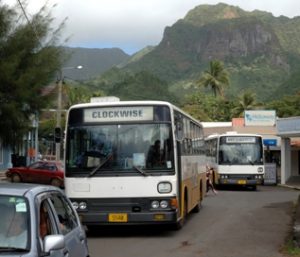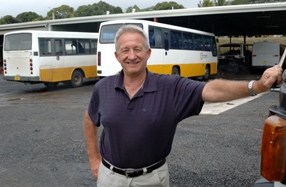
By Henrik Byrn
In the South Pacific where coral reefs surround each of the 15 atolls that make up the Cook Islands, only two bus routes run on the main island of Rarotonga. One runs clockwise, the other anti-clockwise to serve the population of 14,000. The company owner Kevin Cook and his drivers could not ask for a more manageable traffic system.

Cook, who claims no family tie to the English explorer who discovered the islands and named them after himself, arrived from New Zealand in 1968 at age 20. He worked several jobs and eventually developed Cook’s Corner, an array of shops and cafés in the capital city Avarua, before he realized Rarotonga needed a transportation system.
By 1989 he had saved enough money to buy his first bus from one of the hotels on the island — a 15-passenger Mazda van to transport locals and tourists to his corner of town. With no other public transport to and from Avarua other than extended jeeps tours that could not keep up with demand, Cook planned the first bus route to cover the entire island to serve the most remote areas.
Cook says he struggled to get the route going with the old bus breaking down frequently. The purchase of a new vehicle was expensive considering the cost of shipping from New Zealand or Japan. Whenever the bus was out of service Cook hired one of the local public school buses. However, on those days Cook says he always noticed more customers coming through the door.
The buses are bought second-hand in Japan, and it takes about 150,000 NZ-dollars to put a bus in circulation — approximately 75,000 Euros. The Cook Islands economy uses the New Zealand dollar. Once he got the Mazda back on the road, Cook bought a 25-passenger vehicle and initiated his clockwise route system. Business picked up and he was soon able to add to the fleet. A contact in New Zealand had two buses for sale and Cook took them both. When they arrived Cook launched his anti-clockwise route system in 1990. He eventually modernized the flight with two new buses running first clockwise, and then anti-clockwise throughout the day, and initiated a nightly bus service for 80 percent of his tourist trade. He used the older buses as reserves.

Today Cook operates 12 buses in a fleet that includes school and charter buses, and employs a staff of 15, which includes office staff, mechanics, cleaning and maintenance personnel. The entire operation only requires three full-time and six part-time drivers. According to Cook, driving a car on Rarotonga is five times more expensive than taking a bus where Petrol is the world’s most expensive. Cook pays his top drivers 12 NZ-dollars an hour, well over the minimum wage in Rarotonga of five dollars, and he rewards overtime.
Routes start and end at the station in Avarua and follow the winding tropical coastline. Departure times are easy to follow with clockwise buses leaving every hour on the hour; anti-clockwise buses at 25 minutes past the hour. The scenery along the two circular 31-kilometer routes around the island is enough to make any road enthusiast envious. The anti-clockwise route runs parallel to the clockwise route most of the way on the old highway slightly inland flanked by cultivated fields, grazing livestock, tall coconut palms and steep verdant mountain slopes. At times the sky disappears as treetops form natural tunnels.
The water is still crystal clear as the protective reefs further out turn the surf into an azure ring. Nonetheless, the South Seas paradise and the salty air present problems for the bus operator. Drivers complain about the poor road conditions. Huge potholes are difficult to avoid on the two lane routes. The buses bottom out at times, making it necessary to change the shock absorbers before their time. Cook says he has complained about the potholes to the newspapers, local politicians and authorities, and is told to have the drivers register and report any new potholes. Corrosion is an issue, and spare parts are expensive to get by airfreight, while replacement engines arrive on the island by boat. Needless to say Cook and his team employ all methods of repair when a bus breaks down.
In one corner of the garage, they systematically cannibalize the ghostly remains of an old bus for spare parts. The tires have been removed and one side torn open for easier access to the parts they need. “We each have learned to be good at odd-jobs and Jacks-of-all-trades to run this transport company,” says Cook. “We have to be able to improvise, paint, perform maintenance and mechanical work.” The backup marathon bus they call Francy Baby is the pride of the company, having logged more than a million kilometers, which equates to 20,000 trips around the island. Cook named the bus to honor his wife, Frances, as he does with each of his 12 vehicles, naming them after family members — right down the grandchildren.
The small office space is a hive of activity with telephones ringing and people coming and going. Frances is in the process of upgrading the company administration and accounts to a digital system, and every so often, only in special situations, acts as a spare driver. Cook no longer drives, giving more time to enjoy being a rugby fan. T-shirts and trophies line the walls the office. The island’s rugby team enjoys complimentary transportation to and from the stadium. Frances flashes a smile from behind the counter that tells the story — no stress, no problems here.
Henrik Byrn is an international freelance travel journalist.
